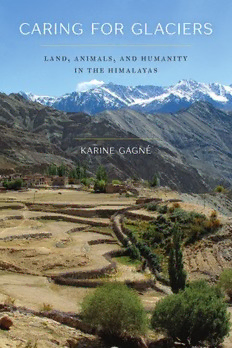Table Of ContentCulture, PlaCe, and nature
Studies in Anthropology and Environment
K. Sivaramakrishnan, Series Editor
Centered in anthropology, the Culture, Place, and Nature series encom-
passes new interdisciplinary social science research on environmental
issues, focusing on the intersection of culture, ecology, and politics in
global, national, and local contexts. Contributors to the series view envi-
ronmental knowledge and issues from the multiple and often conflicting
perspectives of various cultural systems.
F.Gagné, Caring for Glaciers.indd 1 1/15/19 10:38 AM
F.Gagné, Caring for Glaciers.indd 2 1/15/19 10:38 AM
Caring for Glaciers
land, animals, and Humanity
in tHe Himalayas
Karine Gagné
university of WasHington Press
Seattle
F.Gagné, Caring for Glaciers.indd 3 1/15/19 10:38 AM
Caring for Glaciers was published with the assistance of a grant from the
Naomi B. Pascal Editor’s Endowment, supported through the generosity
of Nancy Alvord, Dorothy and David Anthony, Janet and John Creighton,
Patti Knowles, Katherine and Douglass Raff, Mary McLellan Williams,
and other donors.
Copyright © 2018 by the University of Washington Press
Printed and bound in the United States of America
Composed in Warnock Pro, typeface designed by Robert Slimbach
22 21 20 19 18 5 4 3 2 1
All rights reserved. No part of this publication may be reproduced or transmitted
in any form or by any means, electronic or mechanical, including photocopy,
recording, or any information storage or retrieval system, without permission
in writing from the publisher.
university of WasHington Press
www.washington.edu/uwpress
Cover photograph of Himalayan village is by the author.
Interior photographs are by the author unless otherwise noted.
Maps are by Adam Bonnycastle.
library of Congress Cataloging-in-PubliCation data
Names: Gagné, Karine, author.
Title: Caring for glaciers : land, animals, and humanity in the Himalayas /
Karine Gagné.
Description: Seattle, Washington : University of Washington Press, [2018] |
Series: Culture, place, and nature: studies in anthropology and environment |
Includes bibliographical references and index. |
Identifiers: lCCn 2018011127 (print) | lCCn 2018031011 (ebook) |
isbn 9780295744025 (ebook) | isbn 9780295744018 (hardcover : alk. paper) |
isbn 9780295744001 (pbk. : alk. paper)
Subjects: lCsH: Glaciers—Himalaya Mountains Region. | Glaciers—India—
Ladakh. | Human ecology. | Environmentalism.
Classification: lCC GB2559.H56 (ebook) | lCC GB2559.H56 G34 2018 (print) |
ddC 179/.1—dc23
lC record available at https://lccn.loc.gov/2018011127
F.Gagné, Caring for Glaciers.indd 4 1/15/19 10:38 AM
To my daughter, Nilza, who came into this world on a winter day so cold
it broke Canadian temperature records, and who has since brought warm
sunshine into every single day of my life.
F.Gagné, Caring for Glaciers.indd 5 1/15/19 10:38 AM
F.Gagné, Caring for Glaciers.indd 6 1/15/19 10:38 AM
Contents
Foreword by K. Sivaramakrishnan ix
Preface xiii
Acknowledgments xxi
Note on Transliteration xxv
introduCtion
Morality and an Ethics of Care in the Himalayas 3
CHaPter 1
The Loneliness of Winter: Continuity and Change
in the High Mountains 28
CHaPter 2
Arthalis and Beyond: A Crack in the Landscape 47
CHaPter 3
Becoming Sentinel Citizens: The Reconfiguration
of Ladakh into a Border Area 72
CHaPter 4
“Father White Glacier”: Incommensurable Temporalities
and Eroding Filial Bonds 92
CHaPter 5
Searching for Aba Stanzin:
On the Predicament of Herders 116
F.Gagné, Caring for Glaciers.indd 7 1/15/19 10:38 AM
CHaPter 6
Intimate Glaciers and an Ethics of Care:
Mutual Recessions 139
ConClusion
As Glaciers Vanish 163
Glossary of Ladakhi Terms 173
Notes 177
References 203
Index 223
F.Gagné, Caring for Glaciers.indd 8 1/15/19 10:38 AM
foreWord
as environmental antHroPology graPPles WitH tHe idea of
living in the Anthropocene, scholars have expectedly taken different paths
to finding what constitutes a credible object of study and how it must be
framed in philosophical terms. For many, the gravity of the realizations
forced on those contemplating life in the Anthropocene has provoked a
rethinking of the ontological status of humanity. This has given rise to
anthropological approaches that variously identify as posthumanism, the
anthropology of life, new materialism, or anthropological examination of
the more-than-human world.
These discussions are not entirely new, and some will suggest they can
be dated at least in recent times to the writings of Donna Haraway, Tim
Ingold, and Bruno Latour.1 Others will aver that these ideas also build on
the persistent effort in branches of environmental anthropology to quiz the
Cartesian nature-culture divide that many feel has contributed to the accel-
erated processes of environmental destruction that have in turn created
the Anthropocene.2 Climate change in this view is but the most dramatic
and widely felt consequence of human disconnection from nature and the
increasing inability to see human and other life, as well as that which may
be lifeless, as inextricably woven together on this planet. In this view, all
things share a common fate—they will be destroyed, largely by the egregious
misconduct and greed of the human race.
Apart from a debate on the best theoretical or philosophical orientations
for studying these world-changing processes, especially in the humanities
and interpretive social sciences, there is also increasing disquiet in some
quarters with the fact that while only some humans (very few as a proportion
of the world population) created the problems, the ones least responsible
face the worst effects. These concerns have given rise to a subfocus within
environmental justice scholarship on climate justice. So, if humans are seen
ix
F.Gagné, Caring for Glaciers.indd 9 1/15/19 10:38 AM

